Cavs Basketball/Globe Sculpture
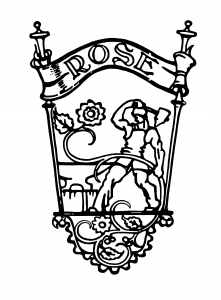 Rose Iron Works: It takes a village, and 2 weeks, to build the world!
Rose Iron Works: It takes a village, and 2 weeks, to build the world!
by Bob Rose, Owner (3rd Generation), Rose Iron Works
On a not so quiet afternoon I was interrupted by an unexpected phone call from Darryle Bajomo, Director of Partnership Marketing for the Cleveland Cavaliers. He was tasked with obtaining a corporate gift to be presented by his CEO to the CEO of a significant supporter, Cleveland Cliffs, and asked if we could furnish a metal basketball.
At first, I tried to refer him to a foundry, but was prompted by Kara, one of our thoughtful staff members, to reconsider. She encouraged me, in spite of an extremely tight timeline, to consider making it ourselves. After “spit balling” design possibilities with Steve, our head art-blacksmith, I agreed to meet with the Cavs’ team to further explore the project. The overriding issue was the absolute requirement to complete it in just three weeks.
I envisioned a desktop sculpture created by forging the seams of a ball rather than forming entire surface of one. Darryle and team member Justine met with me and liked this idea. They asked us for graphics to submit to their management for review. Overnight, Jesse, our CAD expert and Designer, and I came up with a preliminary concept: A hollow ball; supported over a wood base, like the floor of a basketball court, with logos located within the seams of the basketball.
The concept met with approval, but they then asked if we could insert a globe of the world within the basketball. A bit of imagination and 3D modeling allowed us to present them this image a day later.

Now, however, we needed a cost estimate to determine whether it was a viable project, and it is hard to define an exact price before determining a design! After review with management, the Cavs rep called to say it was a “go” if we could commit to deliver in two weeks, one of the three had already gone by. And with that the meter started running!
We had no time to create a sphere for a globe in-house. Instead, we found some stainless spheres online and had several shipped to us by the next day. With spheres as our raw materials, we then tested various finishes for the globe as well as textures for the continents.

Simultaneously, in another part of our shop, we further tested the globe concept by approximating North America on a band saw. Now we had a textured mock-up and it met with enthusiastic approval.


Immediately, we began to create shop drawings, including the files to be used for laser cutting the continents, a much more efficient method than hand sawing. Jesse dove right into creating a 3D model to study the proportions.

The technique used to shape the continents involved hammering the textured material over a large convex shaped steel form as well as pounding it into a concave die using a rounded striking tool.

The lack of time inspired some unusual solutions. The convex tooling which we used for forming the continents is the same one we use to produce foundry ladles. The striking tool is a ball stake which Steve uses to make knee protection armor he wears when he does Medieval Recreation activities.

One of the bigger tricks to this project was the timing and careful sequence planning. While waiting for Repko to laser cut the continents Steve began to forge the steel bar which would be formed into the basketball that would fit outside the globe.





It’s an intensive sequence: heat, hand hammer the texture, straighten, flatten edges with power hammer, and remove scale with wire brush.
The pieces were then shaped and welded together to create the ball, mindful of the cardboard model Jesse had created earlier.

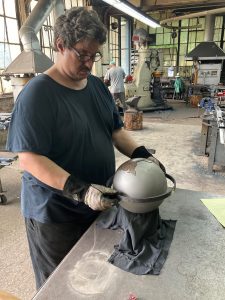



Next, we needed to begin the design work on the base. This would allow time for the machining, and then welding, both required for the finished sculpture. Welder Mike, worked with Jesse and configured a joint design and a process to insure clean, smooth corners. These were flawless. Dan at Christopher Machine then shaped the tapered corner pieces as prep for our assembly.


You can imagine our excitement when we asked if actual court flooring was available and we were given pieces from the floor upon which the team won the 2016 Championship!
Larry Sisson, a close friend and critical part of our team, jumped in and converted the Cavs’ raw flooring into a mini-basketball court. These flooring strips were sawed, sanded and assembled. Several floors were created to allow for the best choice of pattern.
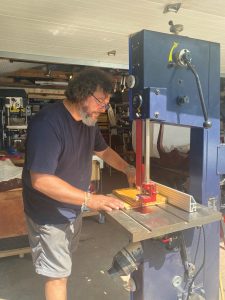
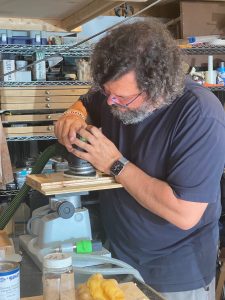
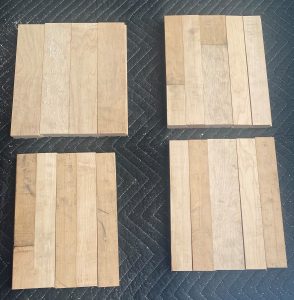
While Larry was working on the floor, I researched the company which makes the Cavs’ floors and then which company maintains them. Jeff Moyer at Cincinnati Floor Company was excited by the project and went out of his way to hand deliver a sample jar of Bona Sport Poly 350, the exact product which they use to treat the arena floors. This created a beautiful glossy base for the sculpture.
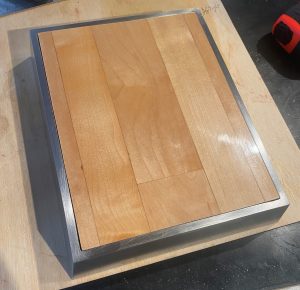

By this time, the continents had been laser cut. We received them in sections. Each piece needed to be removed, have the kerf ground, and then formed into the spherical shapes.
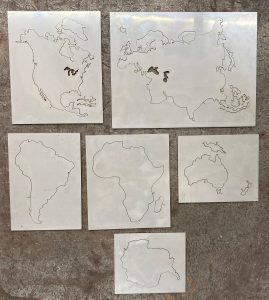
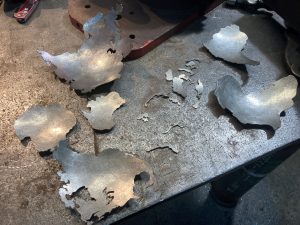
The pieces were then sandblasted and then chemicals were used to darken and create the desired color on the stainless steel surface. Each piece had to be coated, rinsed, dried and polished to achieve the desired appearance.
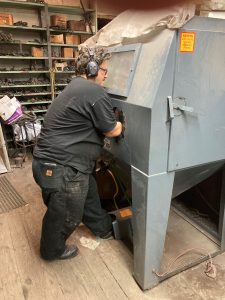
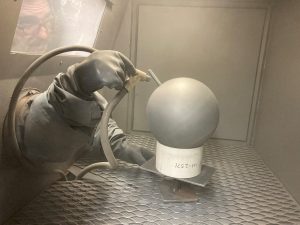
With only a few days left, multi-tasking and sequence planning was critical.
Now we were faced with the “ship in bottle” question! How were we going to insert the globe in the basketball?
We determined that the upper section of the basketball had to be removable. A long-standing tradition at Rose Iron Works is that all fasteners must be minimally observable at best. To achieve this here, the joints needed to be pinned. Another of our village of skilled craftsmen was tasked with machining the ends of the basketball seam bars to accept small pins, which are locked in place with even smaller set screws. Dan at Christopher Machine did this overnight!

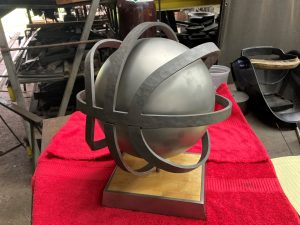
Now we had to prepare the actual sphere we were going to use. A 10” steel ball was sandblasted sequentially with abrasive grit and glass bead to achieve the finish we had developed in our earlier tests.
Using a globe of the world as reference, Steve and I established the position of the continents on the sculpture ball. Each piece was taped in place temporarily in order to verify that we had created and aligned them correctly.
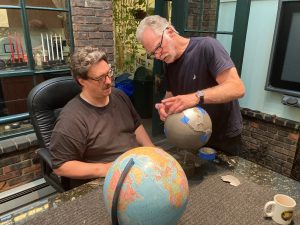
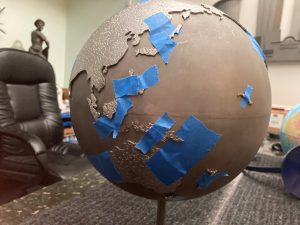
After consultation with our 3M rep, a combination of one of their industrial strength adhesives and locally available gap filling cyanoacrylate was used to permanently fasten each continent and island to the sphere. The globe was then waxed and burnished.
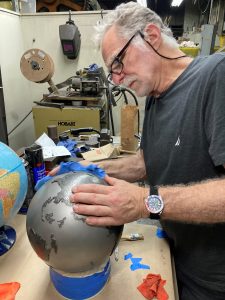
Once all pieces were applied, the sphere was compared to the globe.
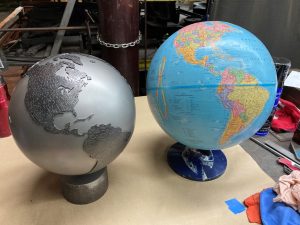
Once again, multi-tasking was critical. Logos had to be created and fastened to the basketball seam framework. These were laser cut from stainless steel, textured, formed to fit the sphere and burnished to achieve the desired satin finish. These were then fit and welded in place.
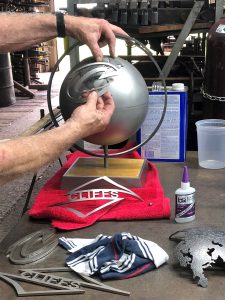
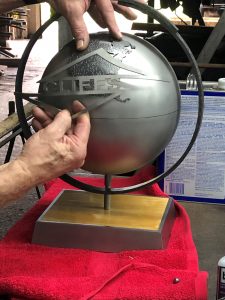
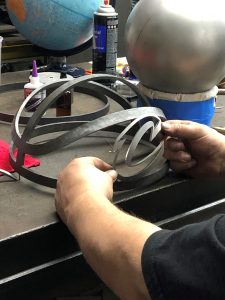
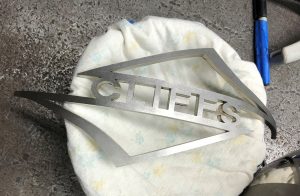
Once all the pieces were completed it was a relatively straightforward task to assemble the final sculpture.

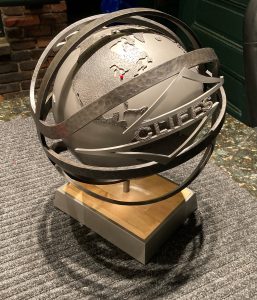
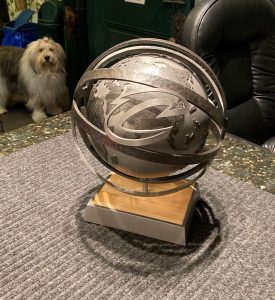
The one aspect that is hard to see in a picture, and that I think is the most fun, is that that both the globe and basketball were designed to spin independently on their vertical axes!
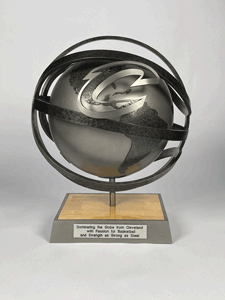
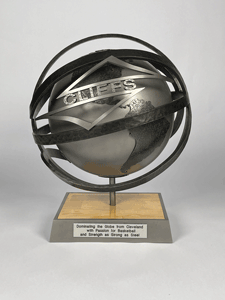
The final product:
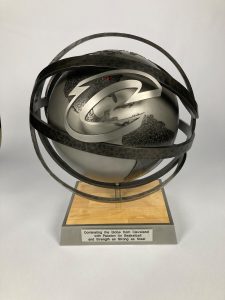
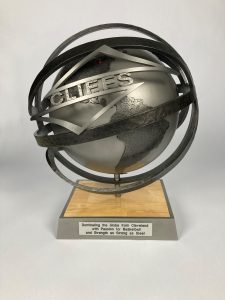
As a third generational artisan I really feel that this sculpture would have made my father and grandfather proud. It makes me happy to continue to carry on the Rose Iron Works legacy and tradition, especially with another Cleveland institution like the Cavs!
To add a bit of perspective, this project did indeed take a village!!!
Thanks go to the following for their contribution to creating this sculpture:
Kara Aberts – Administrative lead – Original contact and inspiration
Steve Moorhouse – Lead Art Blacksmith – Forging and fabrication
Jesse Burns – Designer – CAD drawing and 3D modeling
Jessie Meet – Plant Manager – Coordination of welding
Mike Homa – Welder – Base frame welding
Tony Delco – Purchasing – Acquisition of materials
Will Congress – RMI production – Gopher
Porfirio Santana – RMI driver – Gopher
JP Palmer – Repko Machine Inc – Laser cutting
Dan Christopher – Christopher Machine Co. – Machining of base and ball frame joints
Larry Sisson – Sisson Fine Art Services – Design consultation, base woodwork
Jeff Moyer – Cincinnati Floor Co. – Flooring finish
Rick Serio – All -Craft Wellman Products – Plaque
Jared Bendis – ATBOSH Media Ltd. – 3D modeling consultation and photography
and…
Bob Rose – Designer, Cavs liaison, Project coordinator, extra pair of hands, and worry-master extraordinaire!
We are grateful to Darryle Bajomo, Justine Snyder and the Cavs for this opportunity!
